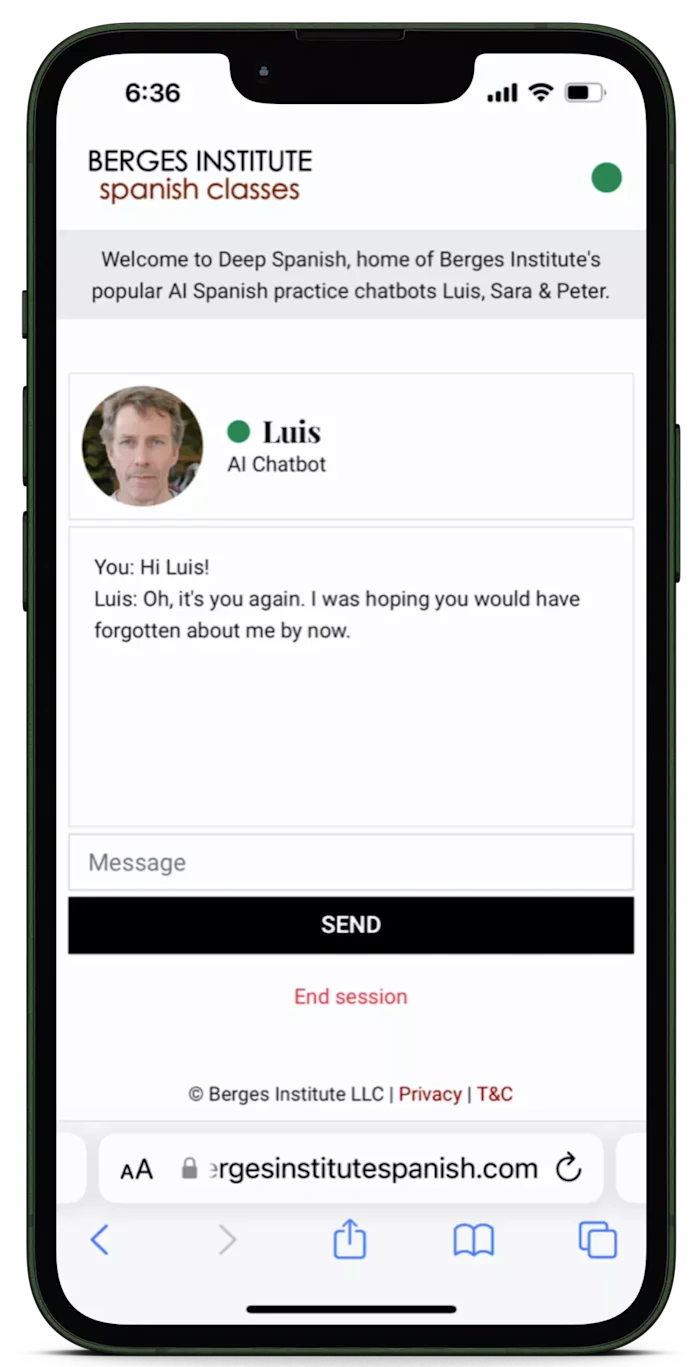
Who are we?
We are a Spanish language school that offers grammar-intensive live Spanish classes via Zoom for adults.
Browse classesIf you've scrolled through social media lately, you've probably seen ads promising fluency through AI-powered conversation practice. The pitch is seductive: practice Spanish 24/7, get instant feedback, no judgment, no scheduling hassles. And honestly? Recent research shows AI chatbots can have a positive impact on language learning, with studies finding medium-sized improvements in speaking and writing skills.
But here's what the apps won't tell you in their marketing materials.
What AI Chatbots Do Well
Let's start with what they actually deliver. AI chatbots excel at providing real-time feedback, reducing speaking anxiety, and offering unlimited practice opportunities. For shy learners who freeze up with human teachers, chatbots create a judgment-free zone. You can make the same mistake fifty times, and the bot won't sigh or check its watch.
They're particularly useful for quick practice sessions whenever you have a free moment, like waiting for your coffee or during your commute. No scheduling, no cancellation fees, no pressure.
The Critical Gaps
But now we get to the uncomfortable truth that tech companies conveniently gloss over in their funding pitches.
1. The Accountability Problem
A chatbot will never care whether you show up. It won't notice when you've been gone for three weeks. It won't ask how your exam went or celebrate when you finally nail the subjunctive. Human tutors provide warmth, accountability, and encouragement that AI cannot replicate. That emotional connection isn't just nice to have. It's often what keeps you going when learning gets hard.
2. The Context Ceiling
Chatbots struggle with deep contextual interaction and nuanced communication. They can correct your grammar, sure. But when you ask "Why do Mexicans use 'mande' but Spaniards don't?", the kind of cultural-linguistic question that reveals how language actually works, you'll get a Wikipedia-style response instead of the rich explanation a knowledgeable human instructor would provide.
3. The Prompt Problem
Here's something most users don't realize: The quality of AI interaction is limited by the quality of your prompts, yet many students receive no guidance on how to construct effective prompts. If you don't know what questions to ask or how to push the conversation deeper, you'll get surface-level practice. A skilled teacher knows exactly what you need to work on next, even when you don't.
4. The Task-Orientation Trap
Students often adopt a task-oriented approach with chatbots, completing specific exercises without reflecting on the actual learning process. You finish your daily streak, feel accomplished, but haven't actually internalized anything. It's the difference between checking boxes and building competence.
5. The Grammar Gap
General-purpose chatbots like ChatGPT weren't designed specifically for language education and can ignore important language-specific details. They might let errors slide, provide technically correct but unnatural phrasing, or fail to catch the subtle mistakes that separate intermediate learners from advanced speakers.
Our Take: Entertainment, Not Education
At Berges Institute, we actually built our own AI chatbots: Luis, Sara, and Peter (you can find them at Deep Spanish). Luis is sarcastically bitter, Sara is enthusiastically friendly, and Peter is a grammar nerd who'll discuss subjunctive mood until 3 AM.
But here's what we tell our students: these chatbots are "for entertainment purposes only" and if you're serious about learning Spanish, take classes with a human.
Our chatbots are fun. They're clever. They can help you practice sentence construction. But they're not a replacement for structured instruction with an experienced teacher who can diagnose your specific problems, adapt explanations to your learning style, and hold you accountable to your goals.
The Verdict
Should you use AI chatbots? Sure, as a supplement. They're excellent for:
Low-pressure practice between real classes
Testing out vocabulary you just learned
Getting comfortable forming sentences
Maintaining your Spanish when you can't access a teacher
But as your primary learning method? That's where they fall short. Their optimal use depends on thoughtful integration with human instruction to enhance emotional support and scaffold complex learning tasks.
Think of AI chatbots like language learning's version of a treadmill. Helpful? Yes. Will it get you in shape if you use it regularly? Probably. But is it better than working with a knowledgeable coach who can design a program for your specific goals, correct your form, and push you when you're ready to level up? Not even close.
The Human Touch
The future of language learning isn't human or AI. It's human and AI, with humans firmly in the driver's seat. Because at the end of the day, language isn't just about grammar rules and vocabulary lists. It's about connection, culture, and communication. And for that, you need another human being.
Want to learn Spanish the way that actually works? Check out our live classes. And if you want to chat with Luis about your existential dread in Spanish afterward? Hey, we won't judge. But he might.

Who are we?
We are a Spanish language school that offers grammar-intensive live Spanish classes via Zoom for adults.
Browse classes
